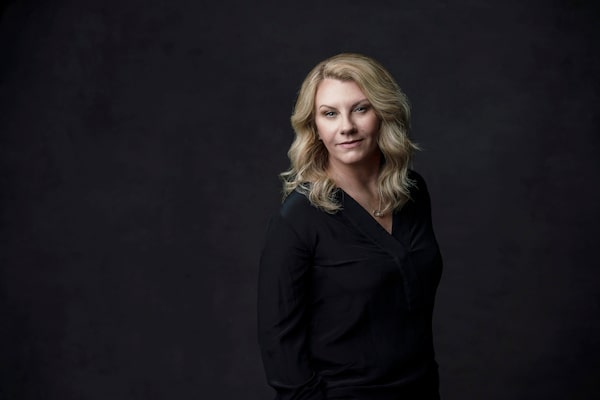
Hope Muir has been appointed artistic director of the National Ballet of Canada, effective Jan. 1, 2022. Photo courtesty of Anastasia Kolotova (NatBallet).© Todd Rosenberg Photography/Supplied
The ballet world has been waiting nearly two years to find out who will replace Karen Kain, the outgoing artistic director of the National Ballet of Canada. After anticipation and speculation, prolonged by 15 months of live-performance deprivation, the company announced Wednesday morning that Hope Muir has been appointed artistic director, effective Jan. 1, 2022.
The announcement might send bemused dance fans straight to Google, hoping to put a face – and, moreover, a biography – to the name. Muir, who has spent the past four years as artistic director of the Charlotte Ballet in North Carolina, is not a well-known personage in the ballet world, let alone a household name in Canadian arts. The appointment marks a change of tack from Kain, who came to the role in 2005 as the luminary Canadian ballerina of her generation, lauded by critics and audiences the world over and admired beyond ballet stages by icons like Andy Warhol.
Dance, fashion and creativity: Karen Kain reflects on her five decades with the National Ballet
But while Muir can’t boast the same name-recognition as Kain, she ticks several boxes that likely appealed to the board of directors. She’s Canadian, surely top criteria for the hiring committee; Muir was born in Toronto and began her ballet training in the city, before moving to the U.K. with her family as a teenager. She has already been the director of a ballet company, something that neither Kain nor her predecessor, James Kudelka, had on their resumé when they took the job. And Muir has extensive experience in both classical and contemporary disciplines, which will be crucial if the National continues to diversify its repertoire. Her 20-year career as a dancer includes long stints at both the English National Ballet and the more innovative Rambert Dance in Britain and Hubbard Street Dance in Chicago.
Artistic directors of major ballet companies are notoriously tricky positions to fill, requiring a person with not only extensive experience as a classical dancer, but also personality, verve, artistic vision and, hopefully, something in the way of business acumen. Many companies hire choreographers for the job, which has the advantage (or runs the risk) of creating a clear direction for the future, conflating the director’s style with the company’s mandate.
This approach has worked well in places like the Frankfurt Ballet, which became indistinguishable from William Forsythe’s 20-year legacy as artistic director, and at Ballet BC, which flourished during Emily Molnar’s tenure. Kudelka’s leadership at the National (1996-2005) gave the company his distinct interpretations of several classics alongside a range of thoughtful contemporary pieces. The approach has worked less well when ambitious choreographers find institutional leadership too taxing or discover that budgetary realities step on artistic toes, as was the case with Benjamin Millepied’s short tenure as head of the Paris Opera Ballet.
Kain never showed ambitions as a choreographer (her upcoming production of Swan Lake is inspired by former artistic director Erik Bruhn’s 1966 version). Instead, her major legacy is to have raised the National Ballet’s international profile, ranking it as a serious company on the world’s radar and attracting dancers of the calibre of Svetlana Lunkina, Jurgita Dronina and Evan McKie. You need only compare what the corps de ballet looked like 20 years ago with the precision, finesse and consistency it has displayed the past decade to get a sense of how much Kain has changed the company’s technical standards. She commissioned new work from sought-after choreographers from around the world, including Crystal Pite, Christopher Wheeldon, Wayne McGregor and Alexei Ratmansky. She’s also promoted the works and career of choreographic associates Guillaume Côté, Robert Binet and Alysa Pires and, as of last year, invited artists from diverse disciplines to make work for the company, including Métis choreographer Jera Wolfe and contemporary, Canadian-Caribbean choreographer Kevin Ormsby.
Like Kain, Muir isn’t a choreographer. She plans to build on the strong edifice that her predecessor and executive director Barry Hughson has created. “It’s been such a successful tenure,” Muir said on the phone from Charlotte. “I feel that the balance of the work has been right. I want to continue pushing the classics forward; I want to try and find those new stories that can speak to all communities rather than just a few.”
Muir says this issue of inclusiveness is essential: “For me, the most important thing is about access. I really want to look at how we’re treating dance and to look at the stories we’re telling,” she said. “Community engagement is something I’ve really prioritized here in Charlotte and something I want to continue.” She also plans to nurture and develop new choreographic talent, something she was committed to at the Charlotte Ballet.
The position will be a big leap in scale for Muir, coming from a regional company of under 30 dancers to a major national institution that employs more than 70 dancers (including apprentices). She’s taking over the reins at a fascinating juncture, a moment that could swell into a cultural renaissance of sorts. It’s a time full of hope and the dance world will eagerly await Hope Muir’s first steps.
“I want to really look at how we can come back out of this pandemic with fresh eyes and more commitment to ballet,” she said. “It’s not quite about reinventing ballet – that sounds egotistical – but to come back to it with eyes wide open about what we’re saying onstage and how we’re representing our community.”
Sign up for The Globe’s arts and lifestyle newsletters for more news, columns and advice in your inbox.